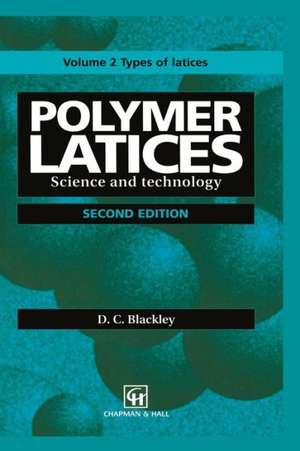Polymer Latices: Science and technology Volume 2: Types of latices
Autor D.C. Blackleyen Limba Engleză Paperback – 3 oct 2012
| Toate formatele și edițiile | Preț | Express |
|---|---|---|
| Paperback (2) | 1231.78 lei 6-8 săpt. | |
| SPRINGER NETHERLANDS – 3 oct 2012 | 1231.78 lei 6-8 săpt. | |
| SPRINGER NETHERLANDS – 17 oct 2012 | 1833.78 lei 6-8 săpt. | |
| Hardback (3) | 1239.37 lei 6-8 săpt. | |
| SPRINGER NETHERLANDS – 30 sep 1997 | 1239.37 lei 6-8 săpt. | |
| SPRINGER NETHERLANDS – 31 oct 1997 | 1839.50 lei 6-8 săpt. | |
| SPRINGER NETHERLANDS – 30 sep 1997 | 2107.04 lei 6-8 săpt. |
Preț: 1231.78 lei
Preț vechi: 1502.17 lei
-18% Nou
Puncte Express: 1848
Preț estimativ în valută:
235.73€ • 243.52$ • 196.19£
235.73€ • 243.52$ • 196.19£
Carte tipărită la comandă
Livrare economică 25 martie-08 aprilie
Preluare comenzi: 021 569.72.76
Specificații
ISBN-13: 9789401064798
ISBN-10: 9401064792
Pagini: 616
Ilustrații: XVII, 592 p.
Dimensiuni: 155 x 235 x 32 mm
Greutate: 0.85 kg
Ediția:Softcover reprint of the original 2nd ed. 1997
Editura: SPRINGER NETHERLANDS
Colecția Springer
Locul publicării:Dordrecht, Netherlands
ISBN-10: 9401064792
Pagini: 616
Ilustrații: XVII, 592 p.
Dimensiuni: 155 x 235 x 32 mm
Greutate: 0.85 kg
Ediția:Softcover reprint of the original 2nd ed. 1997
Editura: SPRINGER NETHERLANDS
Colecția Springer
Locul publicării:Dordrecht, Netherlands
Public țintă
ResearchCuprins
9. Natural lattices.- 9.1 Introduction.- 9.2 Cultivation of natural rubber.- 9.3 Preservation of natural rubber latex.- 9.4 Concentration of natural rubber latex.- 9.5 Constitution of fresh and ammonia-preserved natural rubber latex.- 9.6 Other naturally-occurring latices.- 9.7 Biogenesis of polyisoprenes.- References.- 10. Synthetic latices: general principles of production.- 10.1 Introduction.- 10.2 Emulsion polymerization reactions.- 10.3 Preparation of functionalized latices by emulsion copolymerization.- 10.4 Agglomeration and concentration of synthetic latices.- 10.5 Production of non-aqueous synthetic latices.- References.- 11. Synthetic latices: individual types.- 11.1 Introduction.- 11.2 Latices of styrene—butadiene copolymers.- 11.3 Latices of acrylonitrile—butadiene copolymers.- 11.4 Polychloroprene rubber latices.- 11.5 Latices of vinyl acetate polymers and copolymers.- 11.6 Latices of polyacrylate and polymethacrylate esters: acrylic latices.- 11.7 Latices of vinyl chloride—vinylidene chloride copolymers.- 11.8 Functionalized synthetic latices.- 11.9 Miscellaneous synthetic latices.- References.- 12. Artificial latices.- 12.1 Introduction.- 12.2 Effect of latex particle size upon rate of creaming or sedimentation.- 12.3 Methods of producing artificial latices.- 12.4 Particular types of artificial latex.- References.- 13. Chemically-modified latices: 1. Prevulcanized latices.- 13.1 Introduction.- 13.2 Sulphur-prevulcanization of natural rubber latex.- 13.3 Prevulcanization of natural rubber latex by reaction with organic peroxides (including hydroperoxides), and with hydrogen peroxide.- 13.4 Prevulcanization of natural rubber latex by exposure to high-energy radiation.- 13.5 Prevulcanization of other rubber latices.- References.- 14.Chemically-modified latices: 2. Types of chemically-modified latex other than prevulcanized latices.- 14.1 Introduction.- 14.2 Epoxidation of natural rubber in latex form.- 14.3 Graft-copolymerization reactions in latices.- 14.4 Cis—trans isomerization of natural rubber in latex form.- 14.5 Cyclization of natural rubber in latex form.- 14.6 Halogenation of olefinically-unsaturated polymers in latex form.- 14.7 Hydrohalogenation of olefinically-unsaturated polymers in latex form.- 14.8 Halogenoalkylation of natural rubber in latex form.- 14.9 Depolymerization and oxidation of natural rubber in latex form.- 14.10 Latices containing interpenetrating polymer networks.- 14.11 Modifications involving only the surface of the latex particles.- References.










